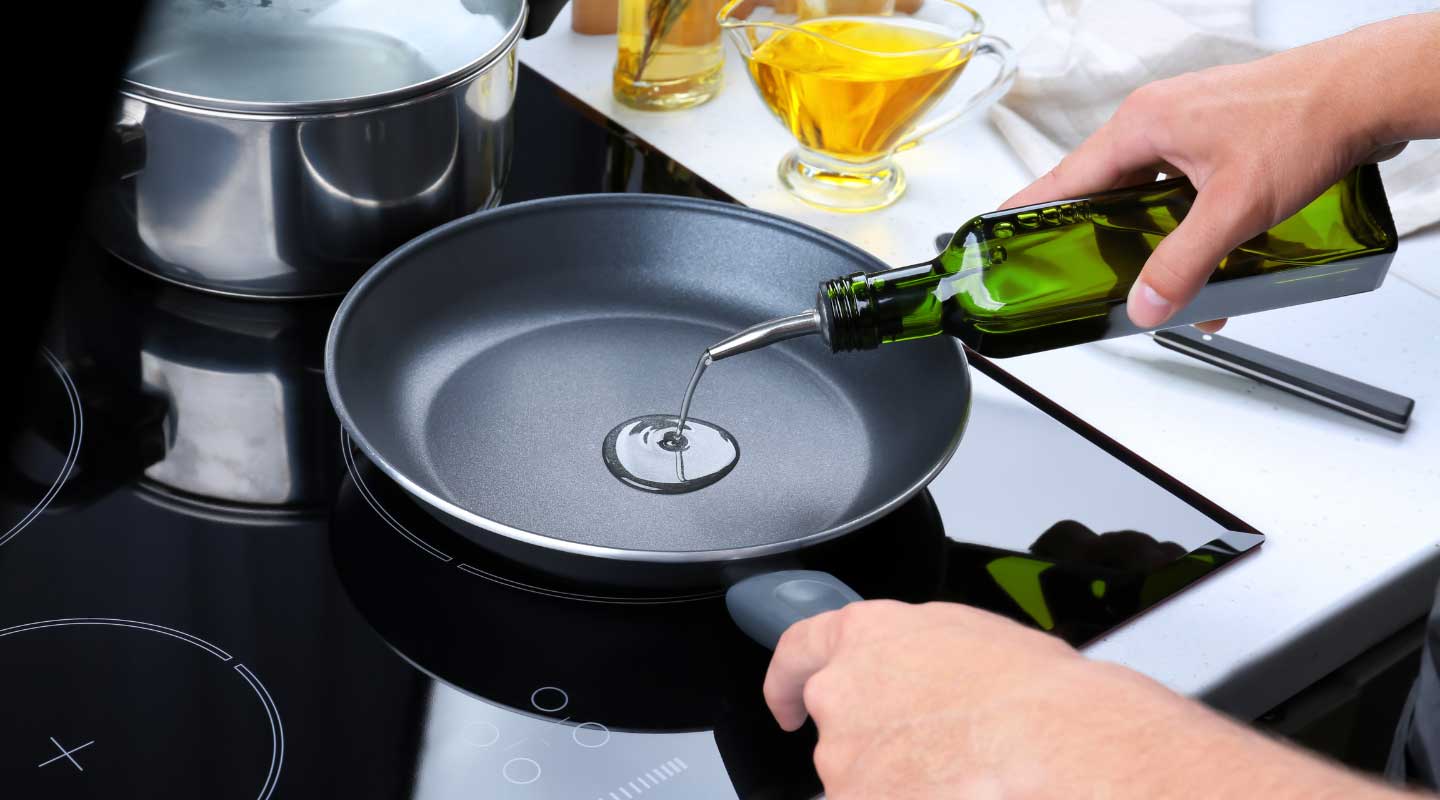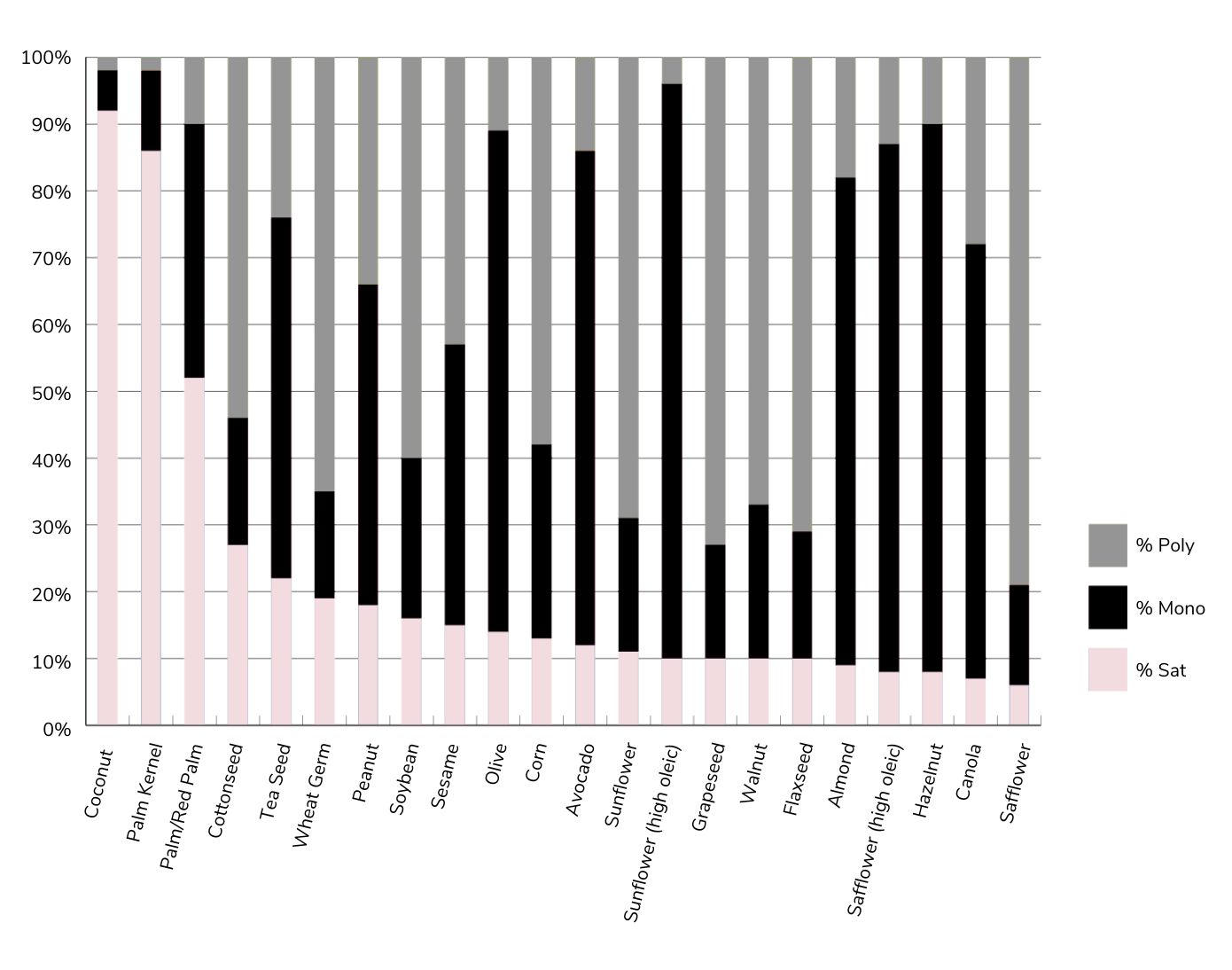
by Stephanie Margolis, R.D.
Using oils in your kitchen is a big part of meal prep. They are an essential component that also adds flavor. However, there are so many options and opinions about oils that it can be hard to know what to use (and when) and what to avoid. So here we will break it down to how you can choose the best oils to stock your kitchen.
First, review the best practices of healthy fats and ways to sustain your omega-3 intake.
While the nutrition side will narrow down your buying decision, there are two other considerations: smoke point and usage.
Simply put, the smoke point of an oil is the temperature at which it will start to smoke. We care about this because an oil starts to denature when it hits its smoke point. This is when the fatty acid molecules that make up the oil change and turn into harmful free radicals. It changes the taste of the oil, making it bitter and burnt tasting.
The smoke point matters because it determines how you can use the oil and why you will likely have several oils in your pantry. Knowing all of this information leads directly to the other consideration for your oil purchases: usage.
How you want to use the oil will determine which oils you can choose from.
We will review this with each oil, but an example is extra virgin olive oil (EVOO) which has a smoke point of 350 degrees. The oil will denature if you try to use it when frying, roasting, or baking (unless you follow the specific olive oil cake recipe).
Baking: Choose an oil that is neutral tasting with a higher smoke point. Baking commonly includes canola oil, butter, and coconut oil as a vegan alternative.
Sauteing and searing: Choose an oil with a lower smoke point but don’t be afraid to play around with flavors. This category can include EVOO and sesame oil.
Dressings: Nothing like an easy homemade dressing! Choose something flavorful like EVOO or a touch of flaxseed oil for a nutty taste. This instance is when you use that special EVOO you love!
Frying: Choose an oil with a smoke point greater than 375 degrees. These include canola oil, refined olive oil (different from EVOO), and avocado oil.

Avocado Oil: This is a newer oil to your supermarket shelves, but it’s super versatile. It is high in monounsaturated fats — the ones good for your heart — and it is high in oleic acid. Oleic acid is known for its anticancer properties and anti-inflammatory properties. What makes it so versatile is it has a high smoke point of 520 degrees, but it can also be used at room temperature. Oleic acid makes the oil great for frying, but you can also use it in the way you use olive oil for dressings or sauteing because it has a neutral taste and will let other flavors shine through.
Extra Virgin Olive Oil (EVOO): This one will not be new to you, but I wanted to give it space to explain why you hear so much about it. EVOO, like avocado oil, is high in monounsaturated fats and oleic acid. It also boasted a healthy amount of vitamin E, a powerful antioxidant. It makes a great finishing oil but save it for low-temperature or no-temperature dishes. Drizzle or saute — no frying or roasting. You may also notice EVOO (and other oils) note they are cold-pressed. Cold-pressed (or just pressed) oils are made by pressing the plant or seeds to extract the oil. In all other types, there are chemicals used to pull the oil from the plant or seed.
Light Olive Oil: You may also see this as regular olive oil. The main difference is its smoke point is much higher, coming in around 465 – 470 degrees. Light olive oil makes a good choice for frying while offering monounsaturated fats, oleic acid, and vitamin E.
Flaxseed Oil: Beloved for its omega-3 fatty acids but is limited in use. You genuinely want to use it as a drizzle — too much and it starts to give a little funky taste. You also don’t want to heat it at all. Otherwise, it starts to denature. Great for drizzling and salad dressings.
Sesame Oil: This is fun because it’s so flavorful (especially if you go for the toasted sesame oil). A smoke point of 410 degrees makes it a deal for sauteing, particularly with Asian-inspired dishes. In addition, it is full of heart-healthy sesamol and sesamol antioxidants, which are neuroprotective and improve the fasting blood sugars of those who enjoy it frequently.
Vegetable Oil: One of the more cost-effective options with a high smoke point of 400 degrees. However, when you buy vegetable oil, you buy a blend of plant-derived oils, most commonly canola and soybean. That makes it difficult to determine the exact nutrition context. Vegetable oil is good for sauteing, though. If you’re on a budget, it does the job.
Canola Oil: Now we Know what canola oil is made of — rapeseed plant (not to be confused with grapeseed). This oil has a high smoke point of 400 degrees and provides monounsaturated fats, polyunsaturated fats, and omega-3 fatty acids. It is okay for frying, baking, and roasting. However, it is not recommended for sauteing or using to make a dressing.
Coconut Oil: This oil is one of the highest in saturated fats. While you want to enjoy coconut oil in moderation, it does make a great vegan butter alternative and adds a sweet coconut taste to baked goods.
A few years ago, research was published surrounding lauric acid for its weight loss benefits and conjugated linoleic acid (CLA) for cancer protection properties. Coconut oil is the only natural food source with lauric acid and CLA, so the connection was made. However, it still didn’t change that coconut oil is one of the oils highest in saturated fats. If you don’t have any health concerns, have no family history of heart disease, and overall your diet is lower in saturated fats, then using coconut oil is completely fine. The biggest thing is portion control.
At the bottom of the list are peanut and palm oil, which are higher in saturated fats.
Butter: Not oil, but it deserves a shout out because it’s the thing you are likely baking with the most. You may be confused about butter if you are a child of the 80s/90s. However, butter is better for you than you thought (and better than margarine) because it is a whole, natural food. Butter is made when the cream is separated from the milk. It is a fat, high-calorie food (but so are all the oils mentioned above). Butter has both saturated and unsaturated fats — about 70% saturated and 27% unsaturated fats. Because butter comes from milk, you also get vitamins A, D, E, B12, and K2. So go ahead and bake with butter and use it for flavor but do so in moderation.
It’s good to have a variety of oils in your kitchen. Staples in mine are high-quality EVOO, avocado oil, and canola oil — cold-pressed, unrefined, and/or organic whenever possible. Remember, all oils are still fats, so use sparingly for food preparation and allow your oil to add flavor and finish to your foods.